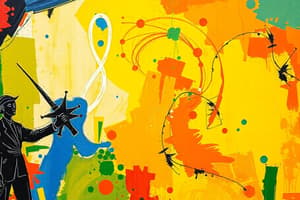Podcast
Questions and Answers
In the 5th century B.C., the ancient Greek playwright ______ created specific costumes for actors.
In the 5th century B.C., the ancient Greek playwright ______ created specific costumes for actors.
Aeschylus
During the Middle Ages and Renaissance, scenery and ______ became increasingly important elements of stage plays.
During the Middle Ages and Renaissance, scenery and ______ became increasingly important elements of stage plays.
costumes
In Shakespeare's time, performers provided their own ______ for the plays.
In Shakespeare's time, performers provided their own ______ for the plays.
costumes
The theatrical style called ______ dell'arte featured costumes that represented stock characters.
The theatrical style called ______ dell'arte featured costumes that represented stock characters.
The requirements of a theatrical costume include depicting the personality and ______ of the character.
The requirements of a theatrical costume include depicting the personality and ______ of the character.
Costume design has a very long ______.
Costume design has a very long ______.
In the Renaissance, costumes helped capture a ______.
In the Renaissance, costumes helped capture a ______.
During the ______, people performed in contemporary dress.
During the ______, people performed in contemporary dress.
The ______ of costumes in the 16th century included recognizable stock characters.
The ______ of costumes in the 16th century included recognizable stock characters.
From the 1770s through the 1870s, the desire for greater accuracy in costume design began to ______.
From the 1770s through the 1870s, the desire for greater accuracy in costume design began to ______.
The color, texture, and silhouette of a costume are extremely ______.
The color, texture, and silhouette of a costume are extremely ______.
The audience should feel a certain ______ when they see the costume.
The audience should feel a certain ______ when they see the costume.
Costumes can aid the performer in their ______.
Costumes can aid the performer in their ______.
Traveling theatrical troops popularized the costume designs from various ______.
Traveling theatrical troops popularized the costume designs from various ______.
Costumes provide a 'general ______' to the audience.
Costumes provide a 'general ______' to the audience.
Flashcards are hidden until you start studying
Study Notes
History of Costume Design
- Costume design has a long history, dating back to ancient Greece
- Aeschylus, an ancient Greek playwright, created specific costumes for actors in the 5th century BC
- In the Middle Ages and Renaissance, costumes and scenery became increasingly important
- These elements helped capture a mood, create an exciting visual experience, and entertain audiences
Shakespeare's Time
- Shakespeare's actors performed in contemporary clothing, and provided their own costumes
16th Century
- Traveling theatrical troupes performed commedia dell'arte, a style of theater
- Commedia dell'arte costumes represented stock characters, allowing the audience to easily identify the character's role
- Examples of stock characters include the serving girl, the doctor, and the harlequin
1770s - 1870s
- From the 1770s to the 1870s, a desire for greater accuracy in costume design grew
- This was due to an increase in stage performances and traveling troupes, exposing audiences to different cultures and costume styles
- Increased popularity of stage performances contributed to the popularity of costume design
Albert Kretschmer
- Albert Kretschmer was a painter and costumer for the Royal Court Theatre in the 1700s
Basic Requirements of a Theatrical Costume
- A theatrical costume should depict the personality, occupation, time period, tone, and mood of the character
- Color, texture, and silhouette play crucial roles in conveying character information
- Costumes should aid performers in their characterization
- Costume design should provide a "general effect" to the audience
- The costume's design and aesthetic should evoke a desired audience reaction, like clapping, laughter, or sadness
History of Costume Design
- Costume design has a long history, dating back to ancient Greece with Aeschylus, who designed specific costumes for his tragedies.
- During the Middle Ages and Renaissance, costumes and scenery became more significant in stage plays, contributing to the mood, excitement, and overall entertainment value.
- There was no standardized definition of costume design during this period.
- In Shakespeare's time, actors performed in contemporary clothing and provided their own costumes.
- Commedia dell'arte, a popular theatrical style in the 16th century, featured costumes that represented stock characters, allowing audiences to immediately understand the characters' roles.
- From the 1770s to the 1870s, a growing interest in accurate costume design emerged due to the increase in stage performances and traveling theatrical troupes.
- The increased popularity of stage performances introduced audiences to costumes from diverse cultures, contributing to the development of costume design.
Basic Requirements of a Theatrical Costume
- Costumes must communicate the character's personality, social standing, time period, tone, and overall mood.
- Color, texture, and silhouette play crucial roles in conveying these aspects.
- Costumes should support actors in embodying their characters.
- Costumes should create a specific "general effect" that evokes a desired audience reaction, whether it be laughter, anger, sadness, or other emotions.
Studying That Suits You
Use AI to generate personalized quizzes and flashcards to suit your learning preferences.




